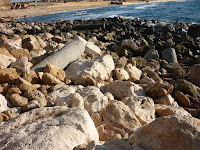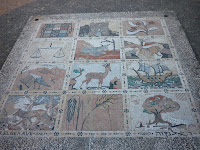 |
| Ruins of port at Acre (Akko |
Are the edges of empire the weakest or most promising places to be? Are they where is manifested the greatest distortion of the center, or its greatest ambition and innovation? I like this taunt, stretching place, full of problems and scrambles for meaning. Seemingly, I have been there (at the edge, not on the edge, I swear) for the past few weeks - far from the center of this writing which has come to mean so much to me. The ice storm cameth, an article was almost completely rewritten, classes became good and complicated, my graduate school advisor was honored (a love letter to New York itself awaits), Big Things are afoot in about five different projects all at the same time, and here it is, I think almost two weeks without writing. I've missed it. I've missed the center whence I could travel and return. And so tonight, deem it necessary. I want to pick up with Israel, whose presence at the edge of empire (Roman, Crusader, other?) makes it as hard as ever to be pithy and focused about. And then also to write about the here and now, those moments of pith and focus that I can treasure out here.
 |
| Street of Sephorris (Tzippori) |
So let's think about Israel as the edges of the Roman Empire. And a city like Sephorris (modern name Tzippori) and its bustling
cardo (the center, or "heart" of any Roman city) and its covered colonnades, and its mixed Jewish and Roman population. It seems to have been a pragmatic city, and we find both a Roman temple and a magnificent synagogue. The legend goes that the Virgin Mary's parents, Joachim and Anna, were from here; that Christ did most of his business here as a carpenter. We're in the region of the Galilee - far from Rome, but framed by Roman tastes and aesthetics, two everlasting forms of Roman conquest: live as we do, it's just so nice.
 |
| The Mona Lisa of the Galilee (Sephorris) |
And so you find the exquisite presence on the floor mosaic of a house, of a woman whose enigmatic grace and absolute belonging in a strange world has had her dubbed the "Mona Lisa of the Galilee." Her demeanor is so utterly self-possessed as to unnerve the viewer - she is beautiful and certain, and we are left to wonder at her presence "out here" so that this edge of empire all of a sudden feels not at the edge at all, but very familiar indeed. The insistent pull of the West on Israel has been felt for a long, long time.
 |
|
| Zodiac in the Synagogue at Sepphoris |
|
I wonder if by the time the spectacular zodiac of the synagogue of Sepphoris was made, its origins in Babylonian astrology were still remembered. Or if it was already by then so thoroughly Greco-Roman that it was another look West instead of East. Animals abound, there are stories of the Hebrew Bible all around - the 2nd commandment against graven images was put aside for a bit here, and the Roman love of visibility prevailed.
 |
| Street in Sepphoris |
How can Israel be at the center of civilizations (Roman and Babylonian, Crusader and Ottoman) and at the edges at the same time? How can a land command so much attention from so far away? The Romans were here so often and so long that the wheels of their carts wore the grooves that you can see here in the
cardo of the city.
 |
| Crusader-Ottoman fortress above Sephorris |
The Crusaders were so insistent on building a fortress up here whence to command their ever-retreating empire, that they used whatever materials they could find, including sarcophagi, which result in those beautiful stretches of decorated marble at the wall's corner. Anthropologists have given us the phrase "the center out there" to signify (I would argue) a desire for possession so strong as to make the unfamiliar intimate. As to make Israel recognizably Roman, as to make it make sense to European Crusaders.
OK - mundane departure: we saw
The Eagle last night with dear friends, and I'll confess that I came for the over-the-top Roman historical action (enhanced greatly by two beautiful young male actors involved in their own complex dynamics of desire, unfamiliarity and intimacy), but I stayed for the British nostalgia for empire as expressed by the woman,
Rosemary Sutcliff, who wrote the book the film was based on in 1954. To this day, as we found out dashing to a bookstore after the film, her books are listed under "Teen Fantasy" (decode
that!) and were written, it seems to us, to remind good British boys of what It (Empire, or the rapidly fading memory of Empire) was all about: honor, certainly; freedom, for some; glory, tons. The story of
The Eagle also takes place at the edges of empire: in the wilds of Britain north of Hadrian's Wall. Master becomes slave, slave becomes master, and the eagle standard of Rome is recaptured from Briton Barbarians to save Fathers' honors. The stuff of imperial fantasy, not just teens. I'll be speaking about the morality of pushes for empire (and other frameworks of Orientalism) at a Really Big Honor lecture in mid-April - I feel like I'm thinking all the time about these moral strategies for empire (without reading or writing nearly enough) - even when I'm out at the movies where I really should just be enjoying a bunch of guys huddled together in one of the best
testudo scenes I've ever witnessed.
 |
| Iced Columns at DePauw |
In one of the thinnest segues ever, I turn to a short reminiscence of this ice storm that threw us off so much and has left so many of us still digging out from under its spell. Everything was completely iced over, including these lone strange columns, a distant displaced echo of Roman grandeur, totally absurdly configured as part of a so-called "Covenant" that students are supposed to abide by. I really can't decode that moral program right now (good lord), but I do love their look, completely sheathed in ice. Everything, everything was like this: every single surface slick and unforgiving and tricky and beautiful. You couldn't walk without falling, you couldn't touch anything without feeling that strange ice burn, and then, there was that incredible moment in the night of the second day of the ice storm: the trees had borne as much of the ice that the steadily falling freezing rain had become as they possibly could, and they all starting cracking. We stood on the front stoop and listened as all over town, these horrendous long cracks tore through the night followed by the crystal sound of tremendous showers of tons and tons of ice. I was thinking of Tolkein's
Ents, because it
is sad to lose a tree, to see it mauled and damaged, to know it will die - especially by the "hand" of this icy cold ice storm grip. It's only now, two weeks and a thaw later, that people are able to make their enormous piles of branches available to be taken away.
 |
| Calvin and Hobbes snowman |
It was sad, but the kids were undeterred in their jollity at so many missed school days. Oliver busied himself with a "
Calvin and Hobbes" snowman, a comic strip that he thinks is absolute genius (which it is). Impish Calvin constantly makes snowman in unspeakably horrid poses, departing from the classic standing pose of most snowmen. Here, the snowman has been felled by several arrows, including one to the head. If you know Oliver, you know that he is without malice - but our front yard bespoke way more dastardly thoughts.
 |
| Cool straw from (where else?) MOMA |
New York gives and gives - the rather big event we organized for my graduate school advisor,
Linda Seidel, was just tremendous: the minute she spoke I was back in a graduate seminar, rethinking everything, feeling that conviction that only she could give us. We're all a good ten years over, but as convinced as ever, that somehow this is All Really Good Work. The bonus was that I was able to reconnect with a friend of mine from
college - we hadn't seen each other in twenty years (she: Japan, me: grad school etc.) and there we were in her cozy West Village apartment one minute, and seeing a
super smart show of Picasso's guitar constructions from 1912-1914 the next, and eating in the swank restaurant of the MOMA, imaginatively called
The Modern after that (yes, scallops seared in pomegranate juice
are delicious). Iris scored the build-your-own-straw set from the MOMA gift shop and here (classic Iris) has designed a straw so that she may share her drink with another. Eleanor then inverted it so as to drink from two drinks in one straw.
 |
| Josselin Castle |
Picasso and Eleanor together let me see how all roads lead to France, too. I think about Jerusalem and feel myself there, but I'm also in France, in Josselin specifically - definitely my center out there. We were deeply there a year ago at this time - two marvelous friends had given us warmth and kindness and belonging, we'd been to the wilds of Brittany north of the megaliths of Monteneuf, the kids were speaking French and we were home. Eleanor tonight, my little hybrid of a speaker, in trying to express her stunned state at the fact that bean thread noodles are also called "glass noodles" (dinner) said "What the quoi?" - she made it sound so natural!!! The kids then spent the rest of the meal saying "What the quoi?" in various voices of surprise, outrage, and goofiness. My favorite: Oliver proclaiming it in a "blabbering cretin voice." What the quoi?
















































